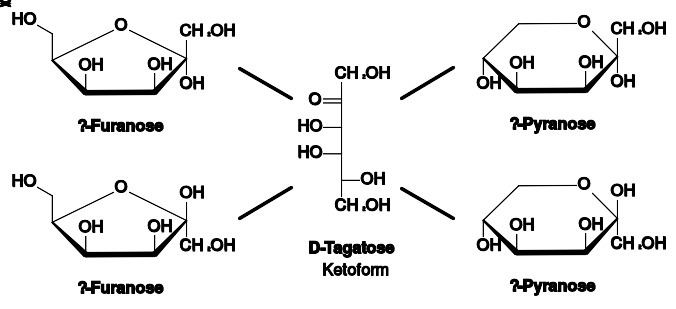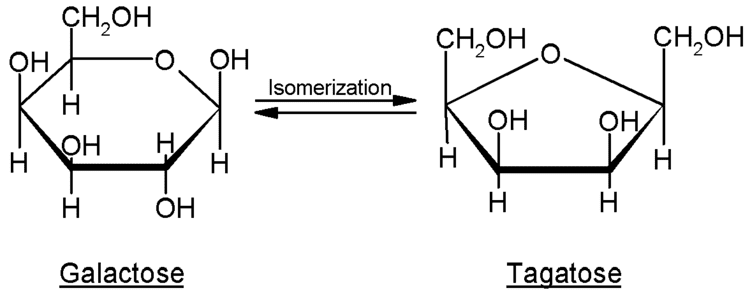Formula C6H12O6 Appearance White solid | Molar mass 180.16 g/mol | |
 | ||
Similar Isomalt, Stevia, Fructose, Saccharin, Fructooligosaccharide | ||
Tagatose is a functional sweetener. It is a naturally occurring monosaccharide, specifically a hexose. It is often found in dairy products, and is very similar in texture to sucrose (table sugar) and is 92% as sweet, but with only 38% of the calories.
Contents
- Tagatose sucre du futur sur rtbf
- Production
- Development as a sweetener
- Safety and function
- Low glycemic index
- Antihyperglycemic effect
- Physical characteristics
- Marketing
- References

Tagatose is generally recognized as safe (GRAS) by the FAO/WHO and has been since 2001.
Since it is metabolized differently from sucrose, tagatose has a minimal effect on blood glucose and insulin levels. Tagatose is also approved as a tooth-friendly ingredient.

Tagatose sucre du futur sur rtbf
Production

Tagatose is a natural sweetener present in only small amounts in fruits, cacao, and dairy products. Tagatose can be commercially produced from galactose through an enzymatic process, starting with lactose which is hydrolyzed to glucose and galactose. The galactose is isomerized under alkaline conditions to D-tagatose by calcium hydroxide. The resulting mixture can then be purified and solid tagatose produced by crystallization.
Development as a sweetener

D-Tagatose was proposed as a sweetener by G. Levin, after unsuccessful attempts to market L-glucose for that application. He patented an inexpensive method to make tagatose in 1988. The low food calorie contents is due to its resemblance to L-fructose.
Safety and function

Food and Drug Administration (FDA) approved tagatose as a food additive in October 2003 and designated it as generally recognized as safe (GRAS). Korea Food & Drug Administration (KFDA) approved tagatose as health functional food for antihyperglycemic effect. European Food Safety Authority (EFSA) approved tagatose as novel food and novel food ingredient. New Zealand, and Australia have also approved tagatose for human consumption.
Low glycemic index

Tagatose has very similar sweetness to sugar while its glycemic index (GI 3) is very low. GI is a measure of the effects of carbohydrates in food on blood sugar levels. It estimates how much each gram of available carbohydrate (total carbohydrate minus fiber) in a food raises a person's blood glucose level following consumption of the food, relative to consumption of glucose. Glucose has a glycemic index of 100, by definition, and other foods have lower glycemic index. Sucrose has a GI of 68, fructose is 24, and tagatose has very low GI compared with other sweeteners.
High blood glucose levels or repeated glycemic "spikes" following a meal may promote type 2 diabetes by increasing systemic glycative stress other oxidative stress to the vasculature and also by the direct increase in insulin levels, while individuals who followed a low-GI diet over many years were at a significantly lower risk for developing both type 2 diabetes, coronary heart disease, and age-related macular degeneration than others.
Antihyperglycemic effect
KFDA approved the safety and function of tagatose for controlling postprandial blood glucose level. Tagatose reduces blood glucose level in the liver by promoting glucokinase activity which promotes transfer of glucose to glycogen. It also inhibits digestive enzymes and degradation of carbohydrates in small intestine which result in inhibition of carbohydrate absorption in the body. Clinical studies have shown that tagatose significantly reduces blood glucose levels among healthy, prediabetic, impaired fasting glucose, and impaired glucose tolerance subjects. Antihyperglycemic function is important for those with both type 1 diabetes mellitus and type 2 diabetes mellitus especially because diabetes is continuously growing and spreading to the younger generation. 92 billion USD was spent for diabetes medication in 2008 in the US, and 50 billion USD is paid in China per year.
Physical characteristics
Tagatose is a white crystalline powder with a molecular formula of C6H12O6 with a molecular weight of 180.16g/mol. Active maillard reaction of tagatose enhances flavor and brown coloring performance and is usually used for baking, cooking and with high-intensity sweeteners to mask their bitter aftertaste.
Marketing
In 1996, MD/Arla Foods acquired the rights to production from Spherix, the American license holder. In the following years, no products were brought to market by MD/Arla Foods, so Spherix brought them before a US Court of Arbitration for showing insufficient interest in bringing the product to market. The companies settled, with MD/Arla Foods agreeing to pay longer term royalties to Spherix and Spherix agreeing to not take further action.
In March 2006, SweetGredients (a joint venture company of Arla Foods and Nordzucker AG) decided to shelve the tagatose project. SweetGredients was the only worldwide producer of tagatose. While progress had been made in creating a market for this innovative sweetener, it had not been possible to identify a large enough potential to justify continued investments, and SweetGredients decided to close down the manufacturing of tagatose in Nordstemmen, Germany.
In 2006, the Belgian company Nutrilab NV took over the Arla (SweetGredients) stocks and project, and set up an 800 tons per year production site in Italy with an enzymatic process from whey for D-tagatose with the brand name Nutrilatose. This process was said to be considerably cheaper than the chemical process previously used by Arla. In 2007 Damhert N.V., the mother company of Nutrilab, released the tagatose-based sweetener Tagatesse under its own brand name, along with some other products (jams and some chocolate-based products) using tagatose in the Benelux and France. Damhert's marketing strategy was to gradually build up the market for tagatose by introducing it to small and medium-sized companies. In 2013, 30% of the profits of Damhert were reported to come from tagatose and they were preparing to scale up their production capacity to 2,500 tons per year. It was also reported in February 2013 that PepsiCo and Yoplait were interested in using tagatose. Damhert were considering in the longer term building a 10,000 tons per annum tagatose plant in Belgium but needed to find the capital to build such a plant.
One of the major producers for D-tagatose is CJ Cheiljedang, Inc. located in South Korea. In 2011, Food and Drug Administration (FDA) approved CJ Cheiljedang’s enzyme conversion tagatose production as a food additive and designated it as generally recognized as safe (GRAS). Also Kosher and Halal food approved. CJ Cheiljedang released ‘Baeksul Tagatose’ as its brand and, moreover in order to notify this fact for global markets including Europe, operates a web site (http://www.cjingredient.com)
